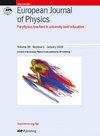A Spherical Version of Feynman's Static Field Momentum Example
IF 0.8
4区 教育学
Q4 EDUCATION, SCIENTIFIC DISCIPLINES
引用次数: 0
Abstract
Abstract The Feynman demonstration that electromagnetic field momentum is real-even
for static fields-can be made more pedagogically useful by simplifying
its geometry. Instead of Feynman's disk with charged balls on its
surface, this article uses the geometry of a hollow non-conducting
sphere with uniform surface charge density. With only methods available
in a typical upper-division electrodynamics course, the initial field
angular momentum and the final mechanical angular momentum can then
be calculated in closed form and shown to be equal.
费曼静态场动量例子的球面版本
费曼证明电磁场动量是实数的——即使对静态场也是如此——可以通过简化其几何图形而在教学上更有用。本文没有采用费曼圆盘表面有带电球的理论,而是采用表面电荷密度均匀的空心非导电球体的几何结构。只有在典型的高级电动力学课程中可用的方法,才能以封闭形式计算初始场角动量和最终机械角动量,并证明它们相等。
本文章由计算机程序翻译,如有差异,请以英文原文为准。
求助全文
约1分钟内获得全文
求助全文
来源期刊

European Journal of Physics
物理-物理:综合
CiteScore
1.70
自引率
28.60%
发文量
128
审稿时长
3-8 weeks
期刊介绍:
European Journal of Physics is a journal of the European Physical Society and its primary mission is to assist in maintaining and improving the standard of taught physics in universities and other institutes of higher education.
Authors submitting articles must indicate the usefulness of their material to physics education and make clear the level of readership (undergraduate or graduate) for which the article is intended. Submissions that omit this information or which, in the publisher''s opinion, do not contribute to the above mission will not be considered for publication.
To this end, we welcome articles that provide original insights and aim to enhance learning in one or more areas of physics. They should normally include at least one of the following:
Explanations of how contemporary research can inform the understanding of physics at university level: for example, a survey of a research field at a level accessible to students, explaining how it illustrates some general principles.
Original insights into the derivation of results. These should be of some general interest, consisting of more than corrections to textbooks.
Descriptions of novel laboratory exercises illustrating new techniques of general interest. Those based on relatively inexpensive equipment are especially welcome.
Articles of a scholarly or reflective nature that are aimed to be of interest to, and at a level appropriate for, physics students or recent graduates.
Descriptions of successful and original student projects, experimental, theoretical or computational.
Discussions of the history, philosophy and epistemology of physics, at a level accessible to physics students and teachers.
Reports of new developments in physics curricula and the techniques for teaching physics.
Physics Education Research reports: articles that provide original experimental and/or theoretical research contributions that directly relate to the teaching and learning of university-level physics.
 求助内容:
求助内容: 应助结果提醒方式:
应助结果提醒方式:


